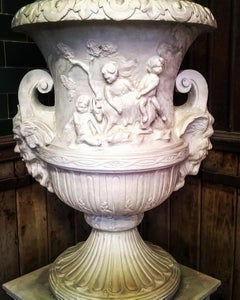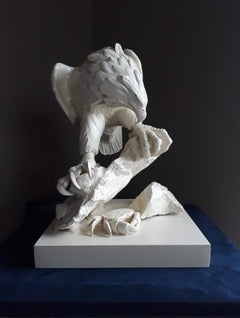Metal Sculptures
1670s American Impressionist Metal Sculptures
Bronze
16th Century Renaissance Metal Sculptures
Bronze
15th Century and Earlier Naturalistic Metal Sculptures
Granite, Bronze
15th Century and Earlier Renaissance Metal Sculptures
Bronze
15th Century and Earlier Renaissance Metal Sculptures
Bronze
16th Century Baroque Metal Sculptures
Bronze
15th Century and Earlier Naturalistic Metal Sculptures
Bronze
15th Century and Earlier Metal Sculptures
Granite, Bronze
Early 17th Century Baroque Metal Sculptures
Bronze
17th Century Baroque Metal Sculptures
Granite, Bronze
Early 17th Century Baroque Metal Sculptures
Bronze
Late 18th Century Metal Sculptures
Bronze
Late 18th Century Baroque Metal Sculptures
Bronze
18th Century Metal Sculptures
Marble, Bronze
18th Century Metal Sculptures
Marble, Bronze
1790s Baroque Metal Sculptures
Brass
1770s Old Masters Metal Sculptures
Bronze
18th Century Old Masters Metal Sculptures
Gold
18th Century Old Masters Metal Sculptures
Gold
17th Century Metal Sculptures
Marble, Iron
18th Century Old Masters Metal Sculptures
Gold
16th Century Baroque Metal Sculptures
Bronze
15th Century and Earlier Naturalistic Metal Sculptures
Bronze
17th Century Other Art Style Metal Sculptures
Bronze
16th Century Northern Renaissance Metal Sculptures
Bronze
15th Century and Earlier Metal Sculptures
Bronze
Early 18th Century Baroque Metal Sculptures
Bronze
18th Century Metal Sculptures
Bronze
17th Century Metal Sculptures
Bronze
18th Century Old Masters Metal Sculptures
Silver
17th Century Naturalistic Metal Sculptures
Marble, Silver
15th Century and Earlier Abstract Metal Sculptures
Iron
1740s Metal Sculptures
Bronze
16th Century Metal Sculptures
Bronze
15th Century and Earlier Tribal Metal Sculptures
Bronze
1660s Metal Sculptures
Bronze
17th Century Baroque Metal Sculptures
Gold
15th Century and Earlier Metal Sculptures
Bronze
15th Century and Earlier Other Art Style Metal Sculptures
Bronze
15th Century and Earlier Metal Sculptures
Bronze
16th Century Metal Sculptures
Bronze
15th Century and Earlier Metal Sculptures
Bronze
15th Century and Earlier Metal Sculptures
Bronze
15th Century and Earlier Metal Sculptures
Bronze
15th Century and Earlier Metal Sculptures
Bronze
15th Century and Earlier Metal Sculptures
Bronze
15th Century and Earlier Metal Sculptures
Bronze
Late 17th Century Other Art Style Metal Sculptures
Gold Leaf
15th Century and Earlier Metal Sculptures
Bronze
Metal sculptures for sale on 1stDibs.
Read More
How the Chunky, Funky Ceramics of 5 Mid-Century American Artists Balanced Out Slick Modernism
Get to know the innovators behind the pottery countercultural revolution.
Art Brings the Drama in These Intriguing 1stDibs 50 Spaces
The world’s top designers explain how they display art to elicit the natural (and supernatural) energy of home interiors.
Chryssa’s 1962 Neon Sculpture Was Way ahead of the Art-World Curve
By working with lettering, neon and Pop imagery, Chryssa pioneered several postmodern themes at a time when most male artists detested commercial mediums.
How to Spot a Fake KAWS Figure
KAWS art toys have developed an avid audience in recent decades, and as in any robust collectible market, counterfeiters have followed the mania. Of course, you don’t have to worry about that on 1stDibs, where all our sellers are highly vetted.
A Giant Wedding Cake Has Us Looking at Portuguese Tiles in a New Light
At Waddesdon Manor, artist Joana Vasconcelos has installed a three-tiered patisserie inspired by the narrative tile work of her homeland. We take a look at the cake sculpture and how Portuguese tiles have been used in architecture from the 17th century to today.
These Soft Sculptures Are Childhood Imaginary Friends Come to Life
Miami artist and designer Gabriela Noelle’s fantastical creations appeal to the Peter Pan in all of us.
Hideho Tanaka Carefully Stitched Together Pieces of Paper to Make This Sculptural Textile
The Japanese fiber artist’s ‘Vanishing and Emerging Wall’ may seem innocuous — but it plays with conceptions of time.
When Art Galleries Join Together, Everybody Wins
Art associations are known for their glitzy fairs, but these organizations do a ton of work behind the scenes to help gallerists and collectors. Here, the heads of five major art associations give us the rundown of what they do.


